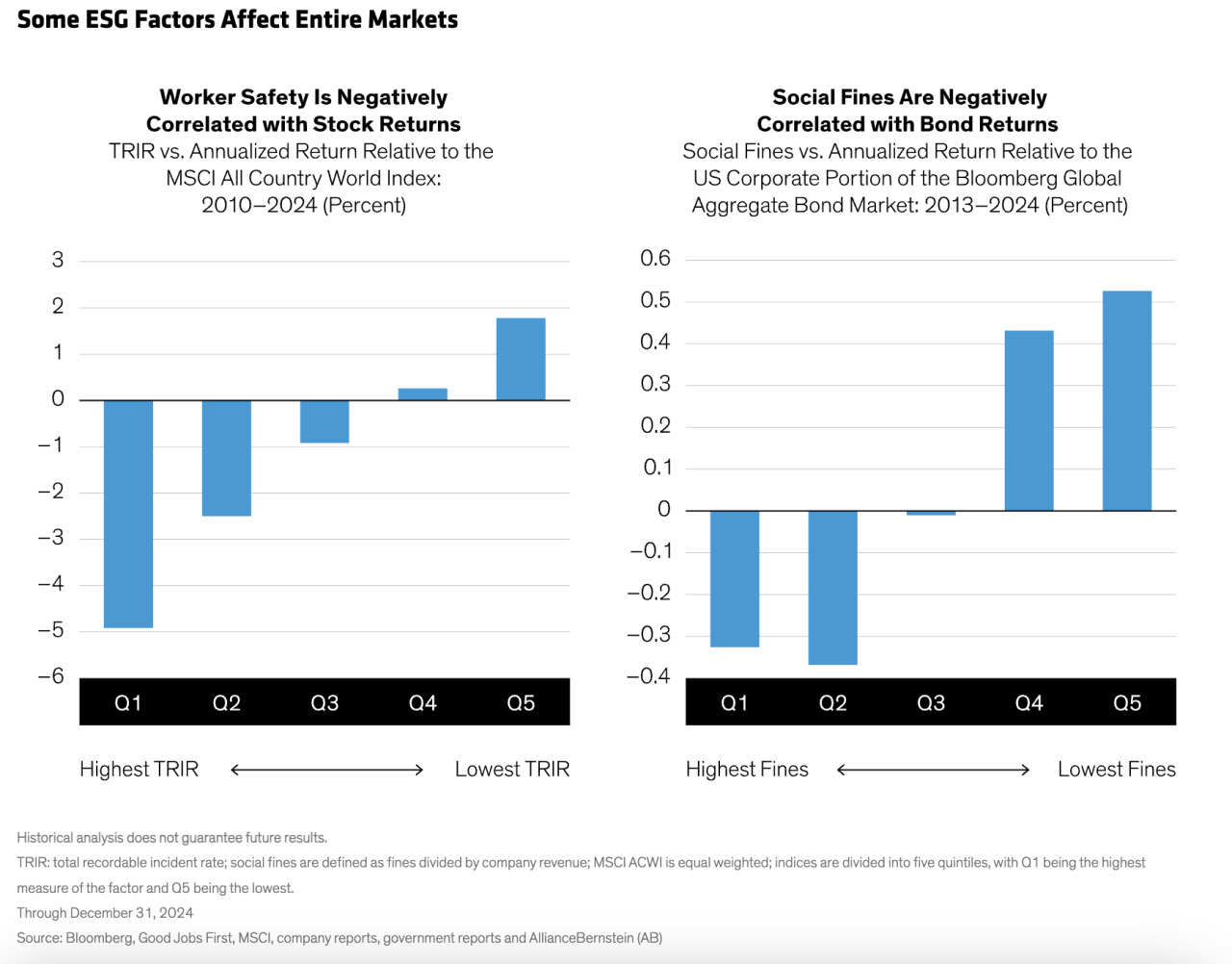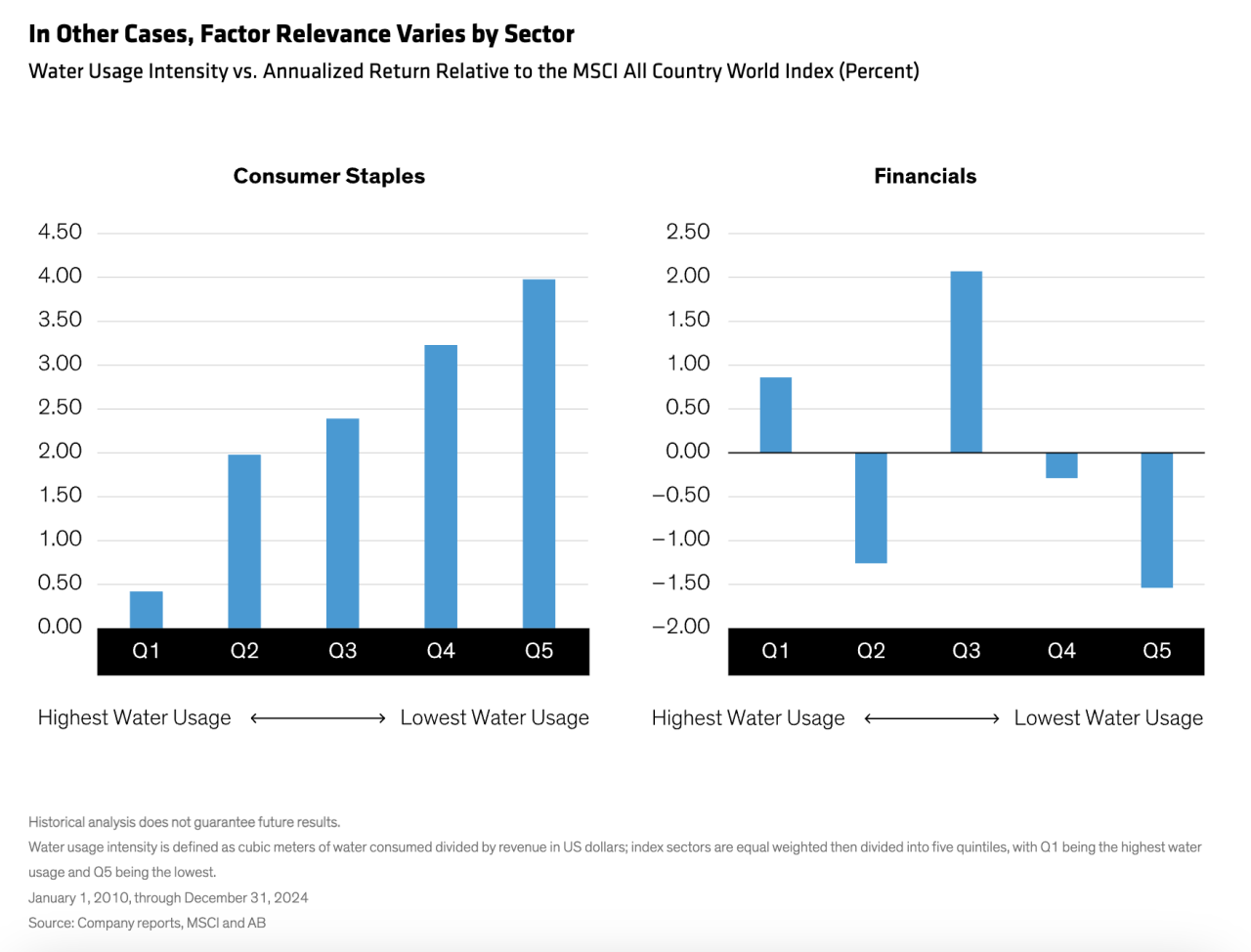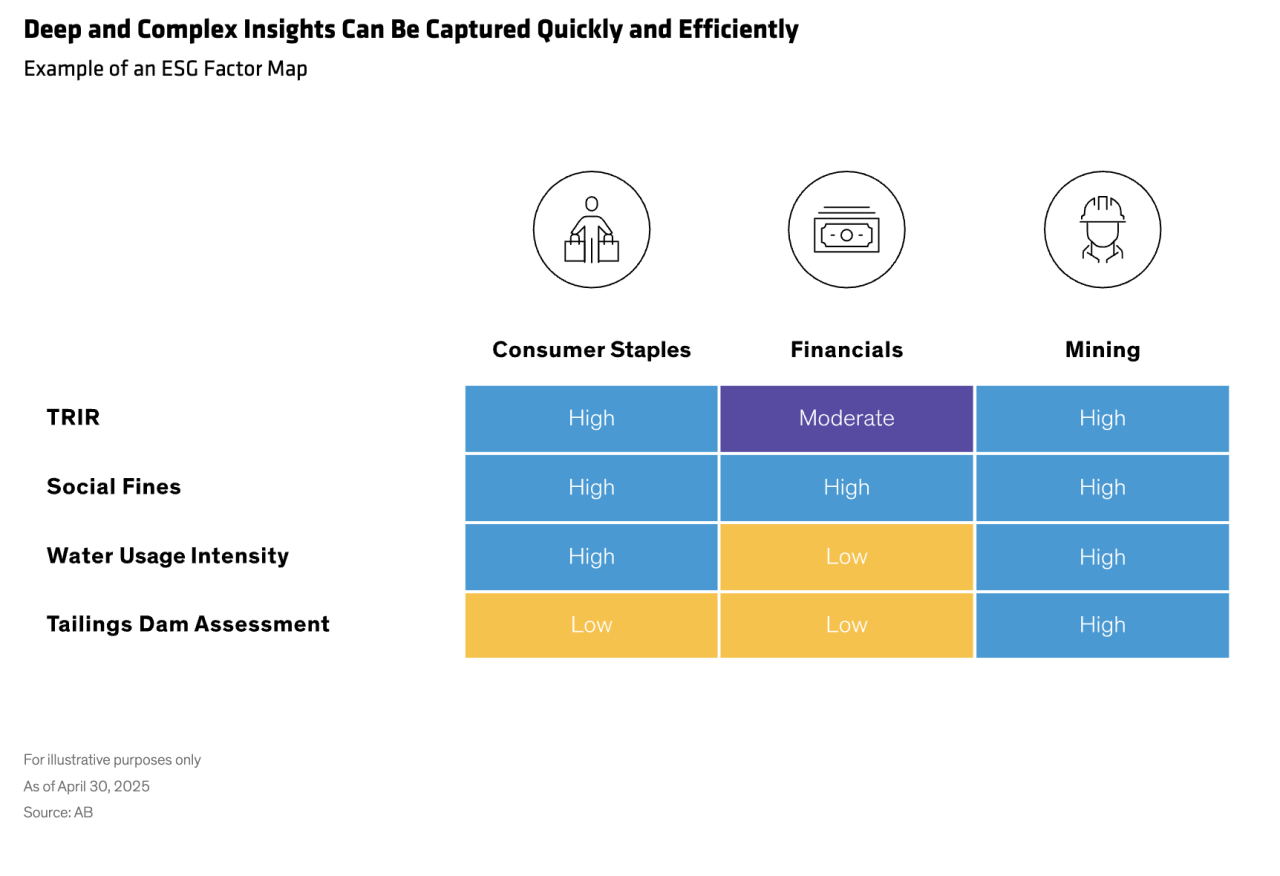AllianceBernstein: Materiality Matters - The ESG Factors That Count
Published 05-30-25
Submitted by AllianceBernstein

Patrick O'Connell, CFA| Director—Responsible Investing Portfolio Solutions and Research
John Huang, CFA| Director of Responsible Investments, Data and Technology—Responsibility
Erin Bigley, CFA| Chief Responsibility Officer
The materiality of ESG factors differs across sectors and markets. Investors need to understand how.
As environmental, social and governance (ESG) factors help contribute to—or detract from—security returns, it makes sense for active investors to integrate them into security selection. But there’s a wide disparity in the materiality of ESG factors across investment sectors and markets. In our view, understanding this dynamic is the key to successfully incorporating ESG risks and opportunities into portfolio construction.
For many investors, whether fixed income or equity, the process of integrating ESG factors into their strategies begins with correlating the relevance of each factor to individual industries. At a basic level this shows, for example, that greenhouse gas emissions are a particular risk for mining companies and electric utilities, while customer privacy is a key concern for the healthcare sector.
This is a good starting point but offers an incomplete perspective. We believe a much deeper dive is necessary to fully dimension the materiality of ESG factors for portfolio performance. Investors need to know how a particular factor may affect investment returns for a given sector or market.
Factors Can Have Wide or Narrow Impacts
Factor attribution using historical returns can reveal how ESG factors have contributed to investment returns in the past, whether for a sector or an entire investment universe, in equities or in bonds.

We’ve observed that some factors can be financially material for all companies in a market, regardless of sector. For example, we divided stocks in the MSCI All Country World Index into quintiles according to their total recordable incident rate (TRIR)—the number of workplace injuries or illnesses—then compared their returns relative to the parent index over 14 years. The results show that high TRIR consistently underperformed the market and that low TRIR consistently outperformed.
Similarly, in the bond market, “social fines” is a powerful, index-wide factor. Social fines are regulatory penalties imposed for nonenvironmental reasons, such as workplace health and safety and anticompetitive practices.
Other ESG factors with broad relevance across investment sectors include CEOs’ length of tenure and employee turnover. For investors wishing to integrate ESG factors into their portfolios, it’s useful, in our view, to know which factors have index-wide applicability.

Factor attribution can also reveal which ESG factors are particularly relevant to a specific sector and which have historically shown no financial materiality.
Another advantage of factor attribution is that it can lead to observations that are unexpected and even counterintuitive. We found, for example, that companies with high ESG disclosures broadly performed better than those with low or no disclosures, regardless of whether their ESG practices were good, bad or indifferent. In the case of ESG metrics where there was no significant under- or overperformance relative to the market—CFO tenure and split roles for CEO and chair of the board—companies that disclosed data outperformed companies that didn’t disclose, on average.
Fundamental Research Enhances Insights from Factor Attribution
But factor attribution alone is not enough, in our view; it should complement fundamental research.
Understanding the effect of ESG factors on performance is most valuable in the context of broader research into how well a company is managed. For example, fundamental research can show that a high TRIR affects productivity directly, through lost working hours, and indirectly, by creating a culture in which workers are undermotivated because they don’t feel safe. Additionally, factor attribution works best with long data series, which are not always available, stressing the importance of fundamental research.
Another way fundamental research can help is in measuring ESG factors appropriately to a particular sector, instead of taking the generic approach typically used by many third-party ESG databases. This could mean, for example, measuring carbon emissions in terms of miles per gallon for automakers, per passenger mile for airliners and per ton of cement produced for building-material companies.
And it can tease out the nuances underlying many ESG factors. In the case of the mining sector, for example, fundamental research can focus on tailings dam risk within the more broadly defined factors of water and hazardous materials management.
As this small snapshot of an ESG materiality matrix shows, these insights can be mapped very simply. But it’s the quality of the information behind it that gives the map its value: the understanding of how ESG factors can be financially material across investment sectors, industries and markets. By embedding such knowledge in their securities research and portfolio construction, investors, in our view, may significantly enhance the potential for outperformance.

The authors wish to thank Peter Højsteen-Ljungbeck for his contribution.
The views expressed herein do not constitute research, investment advice or trade recommendations and do not necessarily represent the views of all AB portfolio-management teams. Views are subject to revision over time.
MSCI makes no express or implied warranties or representations, and shall have no liability whatsoever with respect to any MSCI data contained herein.
The MSCI data may not be further redistributed or used as a basis for other indices or any securities or financial products. This report is not approved, reviewed or produced by MSCI.
Learn more about AB’s approach to responsibility here.

AllianceBernstein
AllianceBernstein
AllianceBernstein (AB) is a leading global investment management firm that offers diversified investment services to institutional investors, individuals, and private wealth clients in major world markets.
To be effective stewards of our clients’ assets, we strive to invest responsibly—assessing, engaging on and integrating material issues, including environmental, social and governance (ESG) considerations into most of our actively managed strategies (approximately 79% of AB’s actively managed assets under management as of December 31, 2024).
Our purpose—to pursue insight that unlocks opportunity—describes the ethos of our firm. Because we are an active investment manager, differentiated insights drive our ability to design innovative investment solutions and help our clients achieve their investment goals. We became a signatory to the Principles for Responsible Investment (PRI) in 2011. This began our journey to formalize our approach to identifying responsible ways to unlock opportunities for our clients through integrating material ESG factors throughout most of our actively managed equity and fixed-income client accounts, funds and strategies. Material ESG factors are important elements in forming insights and in presenting potential risks and opportunities that can affect the performance of the companies and issuers that we invest in and the portfolios that we build. AB also engages issuers when it believes the engagement is in the best financial interest of its clients.
Our values illustrate the behaviors and actions that create our strong culture and enable us to meet our clients' needs. Each value inspires us to be better:
- Invest in One Another: At AB, there’s no “one size fits all” and no mold to break. We celebrate idiosyncrasy and make sure everyone’s voice is heard. We seek and include talented people with diverse skills, abilities and backgrounds, who expand our thinking. A mosaic of perspectives makes us stronger, helping us to nurture enduring relationships and build actionable solutions.
- Strive for Distinctive Knowledge: Intellectual curiosity is in our DNA. We embrace challenging problems and ask tough questions. We don’t settle for easy answers when we seek to understand the world around us—and that’s what makes us better investors and partners to our colleagues and clients. We are independent thinkers who go where the research and data take us. And knowing more isn’t the end of the journey, it’s the start of a deeper conversation.
- Speak with Courage and Conviction: Collegial debate yields conviction, so we challenge one another to think differently. Working together enables us to see all sides of an issue. We stand firmly behind our ideas, and we recognize that the world is dynamic. To keep pace with an ever changing world and industry, we constantly reassess our views and share them with intellectual honesty. Above all, we strive to seek and speak truth to our colleagues, clients and others as a trusted voice of reason.
- Act with Integrity—Always: Although our firm is comprised of multiple businesses, disciplines and individuals, we’re united by our commitment to be strong stewards for our people and our clients. Our fiduciary duty and an ethical mind-set are fundamental to the decisions we make.
As of December 31, 2024, AB had $792B in assets under management, $555B of which were ESG-integrated. Additional information about AB may be found on our website, www.alliancebernstein.com.
Learn more about AB’s approach to responsibility here.
More from AllianceBernstein

